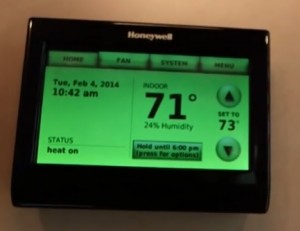
If your HVAC system starts and stops frequently, it may be short cycling which can cause wear on equipment and higher electrical cost.
Thermostats with adjustable cycle rates are something any homeowner can install to lower power costs and help an HVAC system last longer.
What is an Adjustable Cycle Rate Differential Thermostat?
All thermostats have a set temperature that will turn on and off an HVAC system.
The temperature difference that a thermostat turns on and off an HVAC unit is called Differential.
For example, a thermostat with a +-1 degree differential that is set at 70 degrees will turn on an air conditioner on at 71 degrees and off at 69 degrees.
It is also sometimes referred to as the cycle rate since it is the cycle that a unit such as an air conditioner turns off and on.
When HVAC units are turned on and off constantly, it takes a toll on the equipment leading to parts wearing out and needing to be replaced.
A unit that cycles often can also lead to larger electric bills.
Why Does Constant Cycling Have Higher Electricity Cost?
When an air conditioner first starts, is when it has the biggest power draw occurs.
This is mainly due to the compressor, which needs a large draw of power to start running.
After a compressor has been running for a few minutes, the power draw drops.
This is the reason that short cycles can run up a power bill.
Short Cycling Wears on Equipment
When an HVAC unit first powers on also is the hardest time on parts.
A units that cycles frequently causes wear and tear on parts which leads to a shorter life span.
For example, an air conditioner at the start must pump refrigerant through a cooling system which takes more work than it does after it has been running.
How to Get an HVAC Unit to Have Longer Cycles
If your HVAC unit is short cycling, it can be caused by several things, including the outside temperature, an oversized unit, a home not well insulated, and more.
Using a differential thermostat that has an adjustable cycle rate is a quick and easy way to solve this problem.
Your current thermostat may be capable of changing the cycle rate, which can be seen in its manual.
Buying a Differential Thermostat
Most thermostats have a built in differential of +-1 degree, while others will have a +-3 degree differential.
For example, a thermostat with a +-1 degree differential that is set at 70 degrees will turn an air conditioner on at 71 degrees and off at 69 degrees.
With a +-3 degree differential it would turn on at 73 degrees and off at 67 degrees.
Most thermostats are rated for +-1 degree differential.
Thermostats that have “Adjustable Temperature Differential” or “Adjustable Cycles” in their product description will usually have a +-3 degree differential.
NOTE: Be sure to verify any thermostat options and features, as software and hardware can change with version updates.
*This site contains affiliate paid links for which a commission earned.
Adjustable Cycle Rate Differential Thermostats
- Ecobee Smart Thermostat
- Robertshaw RS5110
- Lux Products TX9600TS
The Ecobee has up to a 2.5 Degree differential option. There seems to be variations depending on the model so be sure to verify the differential options.
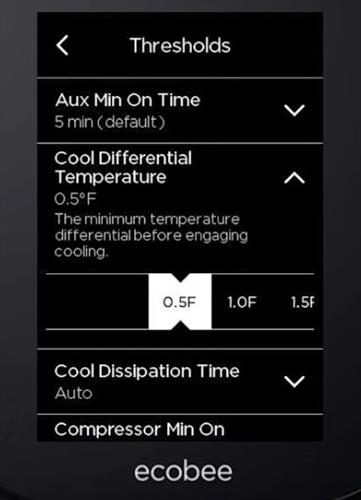
Both heating and cooling have a differential settings.
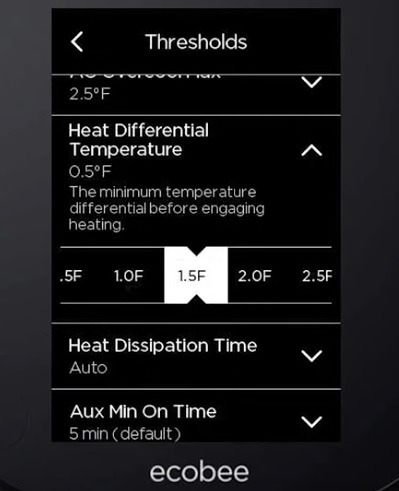
It is a smart thermostat that also can be set up with zones or sensors in multiple rooms.
Having multiple sensors is good for temperature balancing in many homes.
See here for more information on Ecobee Threshold Differential.
The Robertshaw RS5110 thermostat has a set-point differential feature that prevents an HVAC system from short cycling.
It can be set from 1 degree to as much as 3 degrees in half-degree steps. It also has a 5-minute minimum compressor off-time which is great when power is interrupted as not to damage the compressor.
The Lux Products TX9600TS thermostat is listed has having as adjustable temperature differential (swing).
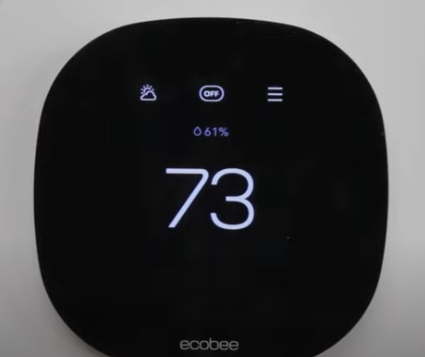
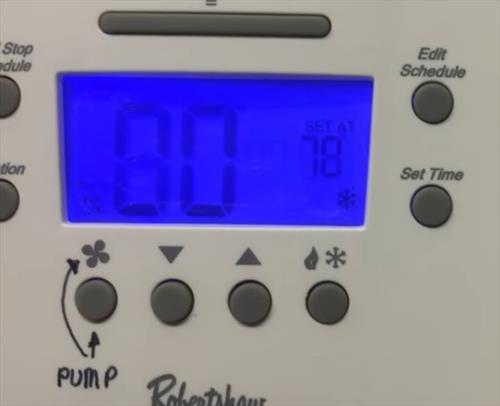
So, how do we remove or turn-off the 1 degree differential to keep the temp at what i set, not something different from what i set?
Does anyone know whether this model supports Adjustable Cycle Rate Differential (+/- 2 Fahrenheit)?
Emerson Sensi Wi-Fi Thermostat for Smart Home, ST55
Could you please update your list for supported devices?
It seems the list is from 2015.
Ali, I have the Emerson Sensi WiFi thermostat & yes, it offers both A/C and Heat cycle adjustments. You can program them easily and separately to your preference (a/c and furnace). The cycle rate, on the app is under settings, system settings, underneath the humidity & temperature offsets. I absolutely love this feature and am thankful my cheap Honeywell thermostat (extremely basic & somewhat outdated model) that came with my hvac broke! Fast will turn it on and off w/in 1 degree, medium 2 degrees (my preference) and slow 3 degrees. It is definitely personal preference, although where I live the fast cycle kept my A/C turning on and off, on and off with little delay between, to be expected w/ 1degree differential.
Actually, the Sensi WiFi unit doesn’t have a 3 degree differential. I contacted Sensi to understand why the Slow/Medium/Fast cycles are all basically the same and they explained that the Slow cycle is only a 0.95. So, it’s just barely below a +1 differential. It’s the biggest fault with the otherwise wonderful Sensi, as I have to manually change the range each time. I’ve run spreadsheets on actual energy usage and the manual range changes are far more cost-effective than the tiny built-in cycles. The Ecobee Smart will likely replace my Sensi, as the Ecobee allows for a +3 differential, which is huge in super-hot desert heat. Maybe other people want their air conditioners to run 4-8 times an hour, but thanks to my manual changes, my A/C averages just 1-2 CPH (cycles per hour), which is a tremendous cost saver and I’m still comfortable.
I agree, they told me the same thing. What a joke.
The Sensi WiFi tstat’s cycle rate “adjustment” doesn’t actually do anything noticeable. I’ve just been round and round with them, and the unit is a joke. It’s sad, because the unit and app are actually very nice with nice features. It just made my unit cycle way too much. Threw away.
So the ecobee solved your short cycling issues? Did you set it to a 2 degree variance? I have a honeywell t6 and seems to only have the built in +|-1 degree. No adjustment except for CPH (cycles per hour). If I am wrong about my honeywell t6 if someone would please let me know.
Thanks
You can NOT adjust the differential range on the ST55U as it is permanently set by the manufacturer at 1 degree. Confirmed that with their support. Not having the ability to set a wider differential makes this device worthless for my place as my HVAC badly short cycles. Was told by sensi that none of their models will have a wider differential –thus go elsewhere.
I have a 2300 ft sq single story home built in 1996, and just last year I had a 3.5 ton heat pump installed that was too large (cycled too often with humidity issues). They replaced it with a 3 ton unit and it is a perfect fit.
I leave in Winston Salem NC – often very humid in the summer. My home is often at 52% RH and I use a dehumidifier in the basement to keep it below 50%RH.
Will the Fast cycle be better at lowering the RH than the other Cycles?
I own a new Sensi WIFI thermostat UP500.
No the faster cycle will not allow enough air to be dehumidified during the process. So longer cycles will greatly accomplish more work than shorter cycles
I had a new 14 seer Maytag HVAC system installed in February of 2020. I live in mooresville NC & it gets quite humid here. The temp inside is set to 75 degrees in the summer. The installer set the differential to 1/2 a degree. This unit runs for 45 minutes, turns off for 5 minutes the back on again. We are being told by the installer that this is normal running time for these new energy efficient units. I’m worried my power bill is gonna be $300-400 because it runs for 50 minutes of every hour. Is this normal? We have a 3 ton unit for a 2300 sq ft house.
A 3 ton unit is not enough for a home your size. 400 – 450 square feet per ton is max. A5 ton unit would be pushing the limit unless your home was supper efficient.
I have a 2300 ft sq single story home built in 1996, and just last year I had a 3.5 ton heat pump installed that was too large (cycled too often with humidity issues). They replaced it with a 3 ton unit and it is a perfect fit.
You would need to get a high efficiency unit with variable speed everything. The fans and compressor slow down to keep it close to desired temp. With a normal system and no differential it would turn on and off every 3 minutes to keep it as close as possible to set temp destroying your compressor in no time. But you will be comfortable. The cooling output of your AC will never perfectly match your house or the temperature outside. Add to that the average human being can’t tell the difference between three degrees.
On a mechanical thermostat, the anticipator setting adjusts the hysteresis.
we just had a new carrier performance series furnace 70 thousand btu installed in our townhome . The thermostat that the installer provided is a honeywell T6pro programmable thermostat. The problem is that the furnace cycles on for 5 minutes and off for 15 minutes day and nite. the furnace is rated at about the same as the unit we replaced.
The installer turned off the program which supposedly senses the room temperature change before it actually goes down. This didn’t help. Still goes on an off every 5/15minutes. The thermostat has a built in swing cycle of -1/+1. He says this cannot be changed. He is going to find a thermostat that has the ability to set the cycle to a wider range ie
-3/+3 . Any suggestions as to what would be a sutable replacement to use. Our old thermostat (12yrs old) would be set at 70 degrees and fire u[p when temp dropped to 69 and run til it reached 71. Any help would be appreciated
press and hold the menu button on the thermostat down for five seconds or until it takes you to the programming menu. The screen will say “device setup.” Hit select then use the right arrow on the touch screen and press until you see “auto differential.” Press edit, then put the auto differential at “00.” Then click “done” to save your changes and then click back 2 times (I believe) to get out of programming.
Hope this helps
Is this a tip for a Honeywell Thermostat? And if yes, what does it make the differential?
Robertshaw RS 5110(5+2 days Pro) , Robertshaw RS 6110 (7 days Pro), Robertshaw RS 4110( None Pro). All of them 1H/1C. Differential 1 to3 F.
Get the T6 Pro manual as a pdf on line. You can set cycles for heating and cooling separately on it. There is an advanced setup on it that has all that. It also recommends 3 cycles per hour for cooling for most ac systems.
I just had to jump in on this, the 1 degree differential is in reference to the set point, as in +/- 1 degree from the set point. In your example of the water vat set to 33 degrees the unit turned on at 34 degrees (+1) from set point and turned off at 32 degrees (-1) from set point, which I would call “operation swing” and not differential.
The difference is a 1-3 degree offset of the desired temperature. If the differential is set at +/- 1 degree, and the temperature is set at 70 degrees. The thermostat will wait 1 degree over the desired temperature (70) before turning on. Then once the desired temperature is reached(70), it will wait an additional degree(69) before shutting the unit off. This way the unit isn’t constantly turning on and off due to temperature changes in the home.
Does anyone make a thermostat with more than a 3 degree differential
i wish, have not seen yet, just 2.25
Controlling thermal hysteresis is the correct approach. It seems obvious many control systems engineers (Presumably those who design thermostats?) are confused by the most basic of subjects.
I am updating to provide information on my search for a thermostat that has excellent swing differential/deadband. The one I found that seems to solve everything is Venstar. Their t-stats can go up to six degrees for each stage! Since I have the basic single stage A/C unit, this is more than enough for me. I have tested it now for almost two months and am very happy. Gone is the need to constantly have my phone next to me so I could update my Sensi t-stat via the app. I was going to wait it out until the autumn, but after the Sensi cloud had a major nationwide meltdown at the end of July 2022, I decided to take the risk on Venstar. The t-stat model I chose is the T3800. I decided against wi-fi this time around, however what’s great about this model is you don’t have to get another t-stat if you do want wi-fi. You can just order the separate wi-fi component and just plug it into the t-stat. Venstar models are hard to find, but I suggest trying DIYcontrols or HVAC Place. Also, Venstar has good customer service. You can’t reach them via phone, but they have a team that works via email. I spent two weeks drilling them with different questions every single day and their answers guided me to the T3800. That was the other issue with Sensi, their customer service is horrible. They kept denying the big meltdown even though their own website noted the big issue. Not good. Also, Sensi/Emerson has been doing recalls on an earlier unit (not Sensi) because it causes fires. I noted how sensitive Sensi was, with temps suddenly changing. As soon as I took it off the wall, it was okay and aligned with the Venstar. That tells me Sensi/Emerson has an issue with wiring, which is scary. Finally, Venstar also allows you to do CPH (cycles per hour) if you don’t want to set the deadband. It was worth the research and I thank this site for allowing me to see that others had the same differential concerns that I had.
I wanted to update some info since my last postings. I still have the Sensi t-stat, because I wanted to really research all the other options available. There are more Smart t-stats now, but they are pretty much adhering to the miniscule swing numbers. I think Ecobee’s latest software update eliminated the 3-degree swing, so they’re out of the picture. Overall, a manufacturer can do a firmware or software update and all your info can be changed in an instant. That may be okay for someone who lives in a temperate climate, but I live in the hot desert and need a defined swing to occur to cool the home. Currently, I have to carry my phone with me everywhere in the summer so I can manually adjust the set points. Ridiculous and Sensi has confirmed they will not change it. It has been suggested to me to look at a Venstar t-stat, so I am communicating with them now, as their Smart and Programmable t-stats have deadband up to 6 degrees. I will post again once the elusive t-stat of heaven is found.
What T-Stat do you end up going with that has the adjustable differential? I’ve been trying to find the right one as well. Supply house was useless!
The differential explanation does not make sense. What is a differential of 1 degree if a unit is set at 70 and comes on at 71 but turns off at 69, as that is a difference of 2 degrees?
Suppose I had a vat of a water solution that I wanted to maintain 1 degree above freezing. My setting would be 33 degrees for the desired setting. Now, I would like for the cooling unit to come on with a 1 degree differential. It would come on at a 1 degree change at 34 degrees, correct? Now, I ask, why would the unit turn off at 32 degrees which would be making the solution freezing? To me, that is a 2 degree change since the unit came on at 34 and then cycled off at 32.
What is confusing me here when we speak of a 1 degree differential?
You’re kidding right? Ok, the unit is set at 70, turns on at 71 and goes off at 69. That’s a 1 degree differential from the 70 degree setting. The overwhelming majority of thermostats have this type of differential setting (some have up to 3 degrees).
But which is the most energy efficient? 1 degree or 2-3 degree differential? It seems with only 1 degree it will cycle more often than 2-3 degree, but in the Deep South where, like today, it is 90 degrees outside with feel-like temp of 104 Because if high humidity. Wouldn’t the unit stay on for hours at a time With 2 degree diff? Thanks for your help
A +1 degree differential doesn’t do much, it’s basically fast-cycling your A/C. You want to have a range, so the +3 differential is best. I have to manually set mine as the Sensi’s pre-set cycles have tiny differentials. For example, we had 112 degree temps with dew points of 72 degrees just a week ago. If I had kept the Sensi stat at the Slow cycle (which has the widest differential at 0.95), my A/C would have been cycling on and off constantly. By using a manual range, my A/C only ran 1-2 cycles per hour.
I just installed a Sensi. How did you manually change the cycle rate? Not finding a way to do that.
How are you manually changing the differential ? I just got off a call with Sensi Tech Support. I have their Sensi ST55U and the HVAC is short cycling. Other than doing the ‘slow’ setting which is a one deg diff they told me there is no way to increase the differential. The thermostat that Sensi replaced had a 2 deg diff and there were no short cycle issues. How are you manually overriding that 1 deg setting ??
This works for the summer –
You can adjust the humidity which will cause the unit to cycle on an overcool up to 3 degrees below the set temperature to remove access humidity. This doesn’t completely solve the issue of over cycling, but can certainly help
I also bought a Sensi, immediately set it to the “slow” cycle setting, and my AC was still cycling way too much (several times an hour) I contacted customer support and they confirmed that the differential can’t be adjusted beyond the Slow cyle – which was way too fast for me. Well…I removed the Sensi and re-installed my 18 year old Hunter…
nuts
i find the 2 degree is too hot then too cold
need smaller swing to be comfy
WELL DAM, ITS AMSZING HOW SOMEONE CAN MAKE THE EASIEST THING HARD
I totally agree with you. I wish my thermostat had a 1/2 degree using the standard terminology. With a one degree differential, I start to feel too warm before the AC turns on. Then , I feel colder than I want before the AC shuts off. Setting a 3 degree differential gives you a 6 degree swing in temperature between turn on and shut off! I have asthma. I could not tolerate such a wide swing. I need and want a more constant temperature, but it seems to be unavailable. The one degree differential, which is a two degree swing is the best you can get apparently. Thanks for posting
Agreed! Clearly men designed these things!!
I would also like to have a 1/2 degree differential. We had a horrible Ecobee 3 Lite that claimed to be able to do it, but no matter what I set it to it kept at a 2 degree differential. After they did some major updates and added an annoying advertisement for their subscription AC filters (Seriously get the K &N washable filters because they’re better than even the highest 3M filters and last 2 years.) the thing started doing pretty much whatever it wanted too. Resetting it, going through all the settings with customer service, none of it helped make it good again. It would do the 2 degree AND run the fan constantly whether you wanted it to or not driving humidity through the roof. Also if their server or your internet were down you would have to get up and manually change it (yes even if it was their server) because they wouldn’t let you use it unless you routed your data through their servers to collect. I have severe RA and 2 degrees colder than I can tolerate is too much. It can send me into a body wide flare with severe pain. I live in Texas, trust me I would love to save money on energy bills, but I also run my temp about 10 degrees warmer than everyone else so it evens out aside from equipment wear and tear.
1 degree from set temp 1 degree up turns on once on goes 1 degree lower than set temp 70